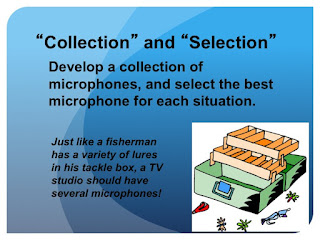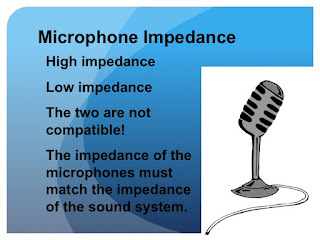Hello class,
I know we were suppose to play Jeopardy today to prepare for tomorrows test. Instead I would like for you to get with a partner and create 25 Jeopardy questions about audio. Please spend 40 minutes of class doing this. The remaining 50 minutes I would like you to pair up with another pair having them face-off to answer your questions and then switch to face-off your partner with their questions.
Pair 1- Jessy & Joe (create 25 questions together) 40 minutes
Pair 2- Chris & Shelly (create 25 questions together)
Jessy- ask Chris & Shelly their 25 questions 25 minutes
Joe- score keeper
Chris- ask Jessy & Joe their 25 questions 25 minutes
Shelly- score keeper
Post scores below in the comment section. You may still be given a test tomorrow!!!! So study!!!
Thursday, November 17, 2016
Wednesday, November 16, 2016
11/16/16 Audio Video Technology II
Hello class,
I am sorry you will not be able to record your music videos. I have the flu and I will be out today, tomorrow and possibly Friday.
In order to cover all standards prior to the semester being over I am going to require that you use chroma key in at least on scene of your video.
The standard is:
I am sorry you will not be able to record your music videos. I have the flu and I will be out today, tomorrow and possibly Friday.
In order to cover all standards prior to the semester being over I am going to require that you use chroma key in at least on scene of your video.
The standard is:
AAVTC-AVTFII-4
Perform advanced editing operations.
Perform advanced editing operations.
-
4.1 Edit multiple layers of video/audio and perform split audio/video edits.
-
4.2 Calculate back time and running time of production
-
4.3 Demonstrate matching action/matching frame editing
-
4.4 Demonstrate special effects processing to include color correction, keying and digital compositing.
-
4.5 Demonstrate maintaining proper continuity for a production.
Please read the following article on creating a great chromakey. Feel free to navigate the website to pick up other tips for your video.
http://filmmakeriq.com/lessons/5-elements-of-a-great-chromakey/
After reading the article you are required to submit a feedback post below with 3-5 sentences of something you learned from the article and how you will apply it to your music video.
Thank you.
11/16/11 Audio Video Technology Level III
Level III
Hello Guys,
Sorry I am out, I have the flu. However we still need to study for the EPOA which will be administered on December 5th... which only gives us 5 class days!!!! But I know you can do it. Please go to this link and read the chapter and answer the review questions. YOUR CORD DEPENDS ON IT!!!!www.g-w.com/pdf/sampchap/9781605258171_ch16.pdf
Hello Guys,
Sorry I am out, I have the flu. However we still need to study for the EPOA which will be administered on December 5th... which only gives us 5 class days!!!! But I know you can do it. Please go to this link and read the chapter and answer the review questions. YOUR CORD DEPENDS ON IT!!!!www.g-w.com/pdf/sampchap/9781605258171_ch16.pdf
11/16/16- Audio Video Tech I
Objective: Given review questions and a powerpoint, complete the all questions on your own by the end of the block.
Tomorrow you will review answers with a partner in preparation for a test on Friday.
Audio Video Tech I Study Guide
Directions: Fill in the blanks and answer the questions
using notes and ohsavtf.blogspot.com
Characteristics of a microphone
1.
Directionality
a.
b.
c.
d.
2. Element
a.
b.
c.
3.
Impedance
a.
b.
4.
Frequency Response
a.
b.
Functions of sound
1.
2.
3.
4.
Wireless microphones have three components. List them
1.
2.
3.
Define a VU meter __________________________________________________________________________________________________________________________________________________________________________
Answer the following EQs (5-8 sentences)
Identify which type of microphone to use in an interview and
why?
__________________________________________________________________________________________________________________________________________________________________________________________________________________________________________________________________________________________________________________________________________________________________________________________________________________________________________________________________________________________________________________________________________________________________________________________________________________________________________________________________________________________________________________________________________________________________________________________________________________________________________________________________________________
Explain the four functions of sound and why they are
essential in digital story telling.
__________________________________________________________________________________________________________________________________________________________________________________________________________________________________________________________________________________________________________________________________________________________________________________________________________________________________________________________________________________________________________________________________________________________________________________________________________________________________________________________________________________________________________________________________________________________________________________________________________________________________________________________________________________
How does the environment where video projects will be filmed
affect the type of generating element used to capture sound in a microphone?
(Only certain microphones can be used in certain environments)
__________________________________________________________________________________________________________________________________________________________________________________________________________________________________________________________________________________________________________________________________________________________________________________________________________________________________________________________________________________________________________________________________________________________________________________________________________________________________________________________________________________________________________________________________________________________________________________________________________________________________________________________________________________
Tuesday, November 1, 2016
Microphones
Read the following paper on microphones by Long Branch public schools and answer the questions handed out in class
How Microphones Work
Microphones are components in
virtually all audio systems. Thus, you'll hear about studio microphones for
recording, PA microphones for live sound, boom microphones for broadcast or
film shoots, instrument microphones which attach directly to guitars or horns,
boundary microphones for conference systems, lapel mics for seminars and
business meetings, and even headset microphones for telephone call centers. The
reason for this diversity is that while all microphones perform the same basic
function, they are adapted to a wide variety of different environments and
uses.
That said,
all microphones have one thing in common: microphones convert a sound wave into
an electrical signal in which the voltage and current are proportional to the
original sound. To perform this task microphones use a thin membrane, known as
a diaphragm, which mimics the function of the human ear.
When sound waves strike a
microphone's diaphragm, they cause it to move within an electro-magnetic field,
which, in turn, creates a variance in an electrical current. This signal is
then transmitted to output devices, which reproduce the original sound wave and
reinforce it. Typical output devices for microphones are power amplifiers,
sound mixers, PA systems and audio recorders.
The internal
configurations of microphones used for 99% of all audio systems have one of
three basic designs, which are often used to organize microphones into distinct
categories. These three categories are dynamic microphones, condenser
microphones, and ribbon microphones.
The link
between the microphone's diaphragm and the output device can be either wired or
wireless. Wired microphones are physically connected by a cable to the output
device. Wireless microphones, which are more portable, must come with both a
transmitter (either FM or InfraRed) and a compatible receiver.
Finally, to
fully understand how microphones work, and the differences among them, it's
important to consider the way different microphones gather sound from the
ambient environment. Microphones can be classified by three types of pickup
patterns: unidirectional or cardioid, bidirectional or figure 8,
omnidirectional or boundary and switchable.
Types of Microphones
Audio
engineers and sound technicians classify microphones using the following
criteria:
The internal configuration of
microphones including dynamic, condenser and ribbon diaphragms:
Dynamic Microphones
In dynamic
microphones a physical cone acts like a lens to concentrate the incoming sound
waves. The concentrated energy of these sound waves moves the cone and its
attached coil of wire back and forth inside a magnetic field. The magnetic
field induces electricity to flow through the wire to produce an electrical
signal which is the microphone's output. The electrical signal is
analogous to the original sound wave: the voltage and current are proportional
to the original sound. Dynamic microphones are well known for their versatility
and their durability, but are not the best choice for reproducing high and low
frequencies; dynamic microphones require significant energy to move the coil of
wire and therefore lose definition at the extremes.
Ribbon Microphones
Ribbon microphones
consist of a thin strip of metallic foil suspended in front of a magnetic
plate. Sound waves cause the foil to vibrate, producing fluctuations in the
electrical current, creating the audio signal.
This extremely sensitive configuration picks up a wide
range of frequencies and produces an extraordinarily rich representation of the
original sound. The trade off for this sensitivity is the delicacy of the
mechanism. These ribbon microphones are also sensitive to physical impacts and
therefore are not considered portable and can be easily damaged by power
overdrive.
Condenser Microphones
Rather than a vibrating wire coil,
condenser microphones have a thin diaphragm and solid back plate which make up
an electronic component known as a capacitor. As the diaphragm vibrates, the
distance from the back plate to the diaphragm varies accordingly. This is known
as fluctuating capacitance. It's the fluctuation that produces an electrical
current, resulting in the signal output. Condenser microphones are used for a
variety of applications, making them an optimal compromise between the sound
reproduction of ribbon microphones and the durability of dynamic microphones.
The external configuration of microphones including
wired or wireless signal transmission:
Wired Microphones
Wired Microphones
Traditionally, microphones - like Model T Fords - came in any external
configuration you wanted, so long as it was wired. The
connection between the diaphragm and the sound system was a hard wired cable
that carried the electrical current to the speakers.
Wireless Microphones
The main advantage of wireless microphones as compared to
wired microphones is freedom of movement. With wireless microphones a vocalist
or presenter has much greater flexibility to move around a stage or among an
audience. The biggest disadvantage is price, as wireless microphones in general
are more expensive.
Characteristically, wireless microphone systems require
a wireless transmitter, and a wireless receiver.
The wireless transmitter is either built into the
microphone itself (as in handheld microphones), or is connected by a short
cable to a body pack transmitter (as in handsfree microphones). All wireless
transmitters require a battery (typically 9-volt or AA batteries) and broadcast
through an internal or external antenna.
The wireless receiver is tuned to the same
electromagnetic wavelength as the transmitter (usually VHF, UHF or IR) and is
physically attached to the output device such as a PA system or a closed system
headset.
Handheld wireless
microphones
Handheld Wireless Microphones are literally held in the hand
of a presenter or a vocalist. In this way the microphones can be used as a prop
in a performance.
Handsfree Wireless
Microphones
Handsfree Wireless Microphones come in three popular
configurations, lapel (or lavaliere) wireless microphones, collar wireless
microphones and headband wireless microphones.
The pick-up pattern of microphones
including unidirectional, bidirectional and omnidirectional:
Unidirectional
Microphones
Unidirectional
or cardioid pickup patterns are most sensitive to sound produced on the front
side of the microphone capsule. Super-cardioid pickup patterns have a greater
sensitivity than cardioid pickup patterns.
Bidirectional
Microphones
Bidirectional
or figure 8 pickup patterns are sensitive to signals emanating from the front
and back sides of the microphone capsule while rejecting sounds from the left
and right sides of the microphone capsule.
Omnidirectional
Microphones
Omnidirectional
or boundary pickup patterns are sensitive to sound from all directions of the
microphone capsule.
Switchable Pickup
Pattern Microphones
Switchable
pickup pattern microphones are hybrid microphones that can be switched from one
pickup pattern to another for all-in-one flexibility in different environments.
Subscribe to:
Posts (Atom)

































